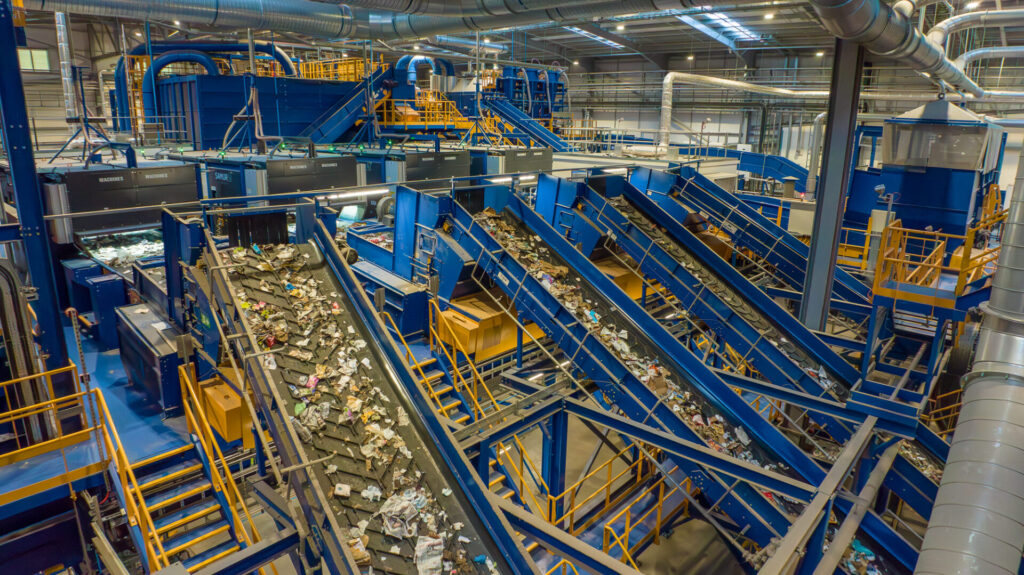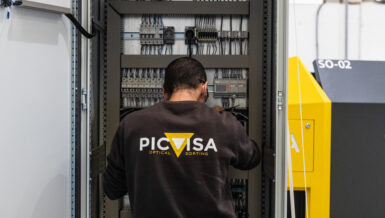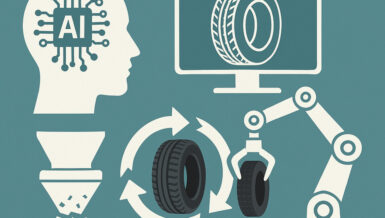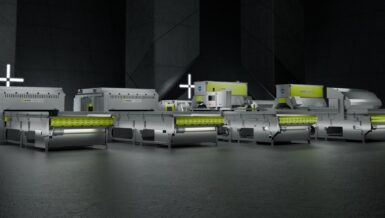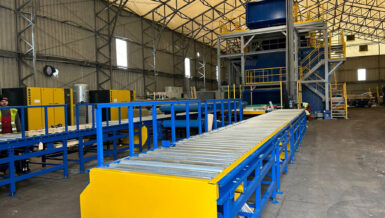Traditionally, these guidelines are tailored to work with near-infrared (NIR) optical sorting systems, a long-standing backbone of the UK’s recycling infrastructure. NIR has several advantages: it is fast, identifying items faster than the blink of an eye, and can distinguish between packaging types based on material signatures. For example, it can detect a polyethylene-lined PET tray among standard PET drinks bottles.
However, NIR systems have limitations. Because they rely on reflected light, dark-coloured plastics, particularly those using carbon black can be challenging or impossible to detect, as they absorb rather than reflect infrared light.
While newer optical technologies are emerging that can identify dark plastics, another revolution is already underway in MRFs: Artificial Intelligence (AI) powered sorting.
AI sorting systems have been installed in multiple UK facilities, often with encouraging results. In some cases, these systems have improved the quality and accuracy of material separation. Yet, their adoption has not been universally welcomed, with stakeholders raising valid questions about whether AI lives up to the hype, or, in some cases, whether it performs too well.
One common concern is that trials conducted at AI-enabled sites produce results that are “too good to be true.” Some stakeholders prefer tests at “normal” sites, fearing AI may skew results unrepresentatively. Ironically, this perception is quickly becoming outdated. The use of AI in MRFs is rapidly becoming the new normal, and non-AI facilities are becoming harder to find for comparative testing.
Another concern involves the economic feasibility of adopting AI. High upfront costs and the complexity of integrating new systems, especially in ageing facilities, can deter investment. Smaller operators may find it difficult to compete with better-funded competitors when bidding for contracts.
Then there’s the issue of job displacement. The fear that automation will replace human workers is widespread, especially amid economic uncertainty and rising living costs. The numbers vary but sources from the Office for National Statistics and The Tony Blair Institute for Global Change estimate job losses between 1.5 to 3 million by 2030. While automation undoubtedly changes job dynamics, it’s not eliminating human involvement entirely. MRFs still rely on human workers for forklift operation, pre-sorting, maintenance, quality control, and to maintain the AI systems themselves. Even AI systems require oversight to function properly.

Rather than replacing humans, AI can work in partnership with existing technologies, like NIR and advanced optical scanners, to deliver smarter sorting. Together, they can sort packaging not only by material type, such as polymer but also by characteristics such as food vs. non-food contact. This offers significant potential to increase the quality and purity of recyclables.
AI also enables better data tracking. By analysing packaging types and their sorting performance, it can identify which brands or pack formats are consistently ending up in the wrong streams. This data can be fed back to brands to improve packaging design or enhance consumer education.
Complementary technologies such as QR codes further enhance this ecosystem. A single QR code can serve different purposes depending on who scans it: for consumers, it might offer product and recycling guidance; for brands, it could enable tracking from production through to disposal; and for recyclers, it could identify polymer type and food contact status.
While these innovations can transform recycling efficiency, human oversight remains essential. Many roles in the recycling chain may be labour-intensive or low-paid, but they are critical to keeping the system functional. For now, the best approach is collaboration between humans and machines to raise the standard of material recovery.
So, what does this all mean for packaging design?
As sorting technologies evolve, so too will Recyclability by Design guidelines. AI and other tools will open the door to more sophisticated sorting capabilities, potentially making previously hard-to-recycle packaging more viable. However, this does not mean that AI is a silver bullet.
AI cannot compensate for poor packaging design. Materials that are multilayered, fused, or improperly labelled can still confuse even the most advanced systems. Effective recycling still depends on good design from the outset, packaging that adheres to well-researched guidelines and can be efficiently collected, sorted, and processed.
Sorting is just one link in the recycling chain. Even if a pack can be sorted, that doesn’t guarantee it will be recycled once it reaches a reprocessing facility. Issues like contamination, material compatibility, and market demand all play a role.
In conclusion, while AI is undoubtedly shaping the future of material recovery, it is not a standalone solution. Its success depends on thoughtful integration with existing systems, ongoing collaboration with human workers, and critically, responsible packaging design. As technology progresses, design guidance must evolve in tandem, ensuring that innovation leads to genuinely sustainable outcomes.
Rather than being fearful of the recycling industries implementation of AI sorting systems, the industry has a chance to embrace it. Throughout history people have been nervous when new technologies come into the workplace. However, often they have been shown to create new roles, improve safety and enable workers to concentrate on other tasks. AI in the recycling industry is not about removing the human but rather enhancing their performance. By engaging with AI and adopting it the recycling industry can build a robust and more resilient recycling system continuing to improve the recycling rates of packaging and products.

